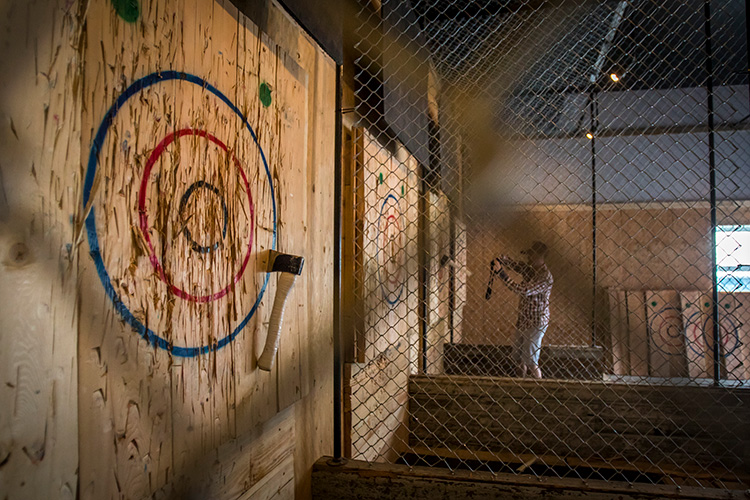Axe Throwing Denver: Experience the most effective of Indoor Leisure
The Enjoyable of Axe Throwing: How This Sport Combines Ability and Adrenaline for a Great Time
Axe throwing has emerged as a mesmerizing sport that masterfully intertwines the demand for precise ability with the rush of adrenaline, offering participants a engaging and unique experience. The act of hurling an axe towards a target demands focus and technique, all at once cultivating an environment of camaraderie and friendly competition. This appealing mix of mental focus and physical effort has actually made axe tossing a prominent option for those looking for both leisure and a feeling of accomplishment. To genuinely appreciate the deepness and allure of this activity, one should consider its beginnings, the needed equipment, and the foundational techniques that make sure both safety and enjoyment.
The Origins of Axe Throwing
Axe throwing, a leisure activity that has obtained significant appeal in current years, traces its roots back to old times. The earliest records of axe usage in affordable contexts are found among the Celts and Vikings, who tossed axes for sport as well as in combat training.
Medieval European warriors, particularly during the Center Ages, exercised axe tossing as component of their martial training. The Francisca, a type of tossing axe used by the Franks, ended up being legendary for its dangerous precision. This traditional tool was made to be tossed at enemy shields and armor, showcasing its dual energy in both sporting activity and fight.
In more recent history, axe throwing saw a resurgence in the logging camps of North America in the 19th and 20th centuries. Lumberjacks would certainly engage in friendly competitors, examining their precision and stamina by targeting at wooden targets. This evolution from a survival ability to a leisure task has led the way for its modern-day resurgence, with devoted locations and organizations currently celebrating the sporting activity worldwide.
Equipment You Required
Recognizing the rich background of axe tossing improves the recognition of the sport's modern model. For entertainment and competitive axe tossing, the most typically made use of type is the hatchet, commonly weighing in between 1.25 to 2 extra pounds with a manage size of about 16 inches.
Equally essential is the target. Policy targets are constructed from wood, with softwood ranges like yearn or cottonwood being preferred for their capacity to hold the axe and take in. The target is typically separated right into five concentric circles, each with a details point worth, to help with scoring.
Safety equipment, though commonly forgotten, is important. Protective gloves can enhance grasp and protect against blisters, while closed-toed shoes are a should to safeguard feet from dropped axes (denver axe throwing). Finally, a well-lit, large throwing location, complete with safety obstacles, guarantees a regulated setting where participants can concentrate on developing their skills.
Fundamental Techniques Explained
Understanding the fundamental strategies of axe throwing is important for both security and proficiency. The dominant hand ought to be positioned straight listed below the axe head, while the non-dominant hand supports the end of the handle.
Your leading foot needs to be a little forward, aligning with your target. This positioning Homepage help in maintaining stability and directing power properly towards the target.

Security First
Ensuring safety and security in axe throwing is extremely important to producing an injury-free and enjoyable experience. A well-designed axe throwing facility features clear demarcations in between tossing lanes, strong backgrounds to capture roaming axes, and non-slip floor covering to stop accidents.
Benefits of Axe Throwing
Axe throwing offers a myriad of benefits that expand beyond basic leisure. The recurring movement of tossing the axe additionally improves hand-eye sychronisation and great electric motor abilities.
Psychologically, axe throwing calls for focus, strategy, and precision, making it a superb means to hone cognitive skills. The focus needed to hit the target can offer as a type of mindfulness, permitting participants to clear their minds and reduce anxiety. This mental involvement can be specifically valuable in aiding people develop far better analytical skills and psychological durability.
Socially, axe throwing is often appreciated in group setups, fostering team-building and sociability. Whether as component of a corporate occasion or a casual getaway with good friends, the sport motivates communication and partnership. Additionally, the common experience of learning and boosting together can enhance relationships and produce lasting memories.
Final Thought

The earliest documents of axe use in affordable contexts are found among the Celts and Vikings, who tossed axes for sport as well as in battle training. Launch the axe when your hands are about at eye degree, allowing the axe's natural rotation to lead it towards the target.
A properly designed axe tossing center functions clear separations between throwing lanes, sturdy backdrops to capture roaming axes, and non-slip floor covering to protect against mishaps. Individuals have to be advised on the proper method to manage and toss the axe, highlighting managed, intentional movements over powerful tosses.
In recap, axe tossing stands out as a sporting activity that masterfully incorporates ability, precision, and adrenaline.